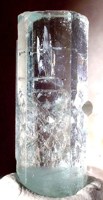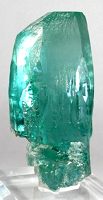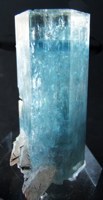Aquamarine Info
Back to Beryl / AquamarineGeneral
 |
| Light blue Aquamarine * |
Aquamarine is usually cut in the step-cut or brilliant-cut. Aquamarine was alledgedly used for spectacles in ancient times.
It is the official state gem of Colorado / USA.
Formation and Resources
Formation
Aquamarine usually occurs in granite pegmatites, as well as in hydrothermal carbonate veins and greisens (highly altered granitic rocks, formed by endoskarn alteration of granite during the cooling stages of emplacement). It is associated with quartz, feldspars, muscovite, biotite, garnet, phenakite, and topaz. Because of its hardness and density, it is also found in alluvial deposits.
* Photo by kind permission of © www.irocks.com, Dr. Robert Lavinsky.
Resources
 |
| Greenish Aquamarine * |
The majority of aquamarine is found in Brazil. The largest aquamarine (110 kg) was found in 1910, at Marambaia / Minas Gerais / Brazil. Other important deposits are in Angola, Kenya, central Madagascar, Malawi, Nigeria, Mozambique, Pakistan, the Ural Mountains in Russia, Tanzania, Colorado / USA, and Zambia. The Brazilian deposits with large, clear, and well crystallized stones are located in Bahia, Espirito Santo, and Minas Gerais. In Brazil, aquamarine is associated with chrysoberyl, topaz, sometimes diamonds and other minerals, found in the sands of the "Minas Novas" district in Minas Gerais. Near Rio de Janeiro aquamarine is found in granite veins penetrating gneiss.
Comparable with the Brazilian deposits are the Russian deposits in the Ural Mountains (Mursinka and Shaitanka), and in Siberia. At first all the aquamarine mines were located in the surroundings of Mursinka. Later other deposits were found in neighboring villages like Alabashka, Sarapulskaya, Shaitanka, Sisikova, and Yushakova.
* Photo by kind permission of © www.irocks.com, Dr. Robert Lavinsky.
History
 |
| Blue Aquamarine * |
Color
The blue color of aquamarine is caused by traces (1 - 2%) of iron substituting the Al atoms in the beryl crystal. The color of a crystal ranges from pale blueish-green to pale blue, depending of the amount of iron in the crystal, and where the iron atoms are located within the crystal structure. Dark colored aquamarine is very rare. A few of such sapphire-blue stones are found at Royalston / Massachusetts / USA.
If Fe3+ replaces the Al atoms, a yellowish color is shown. Fe2+ produces blue crystals. If both are present, the mineral shows a greenish color ("green beryl").
Heat treatment (750° F / 400° C) of green beryl reduces Fe3+ to Fe2+ so that the color changes into blue. Nearly all todays aquamarines are heat-treated.
* Photo by kind permission of Sarah Sudcowsky who called this superb stone "Erongo Emperor" because of its beauty and size (6.5 x 7 x 4 cm, aquamarine on feldspar and perfect smoky quartzes, scattered with schorl).
Value
The prices of aquamarines depend on their color and clarity. Dark blue, flawless stones are most valuable. Heat treatment is generally accepted. Only very good colored (darker blue), perfect stones are higher priced but less valuable than comparable emeralds. Of course the value of a clear, blue aquamarine is proportional to its size. Most people have never seen a deeper blue, valuable aquamarine whose color rivals the blue sapphire color. Light blue aquamarines are priced comparable to green tourmaline.
Today nearly all sizes are easily available. As the size increases, the aquamarine's color intensifies.
⇐ Intro Page ⇐ Gemstones ⇐ Aquamarine